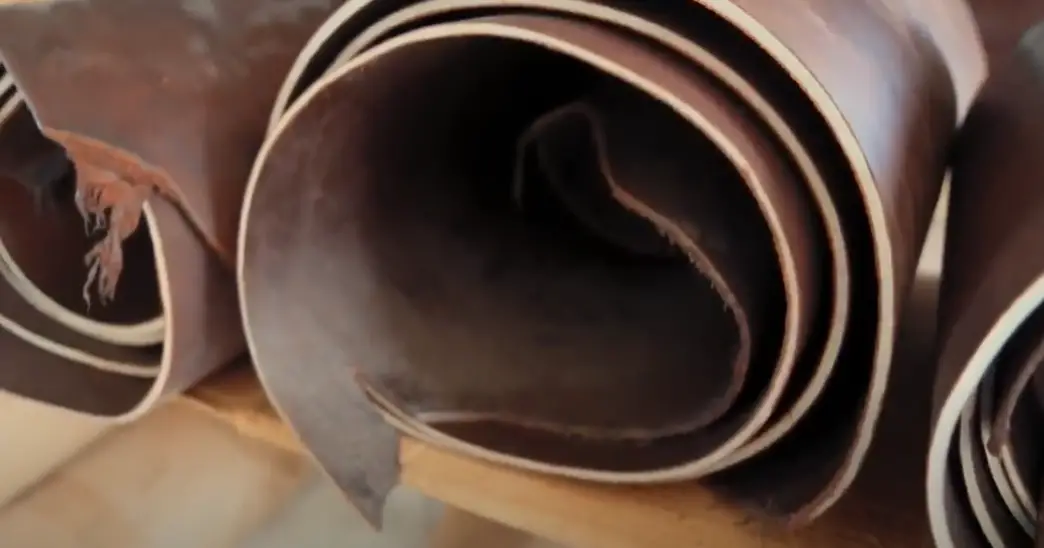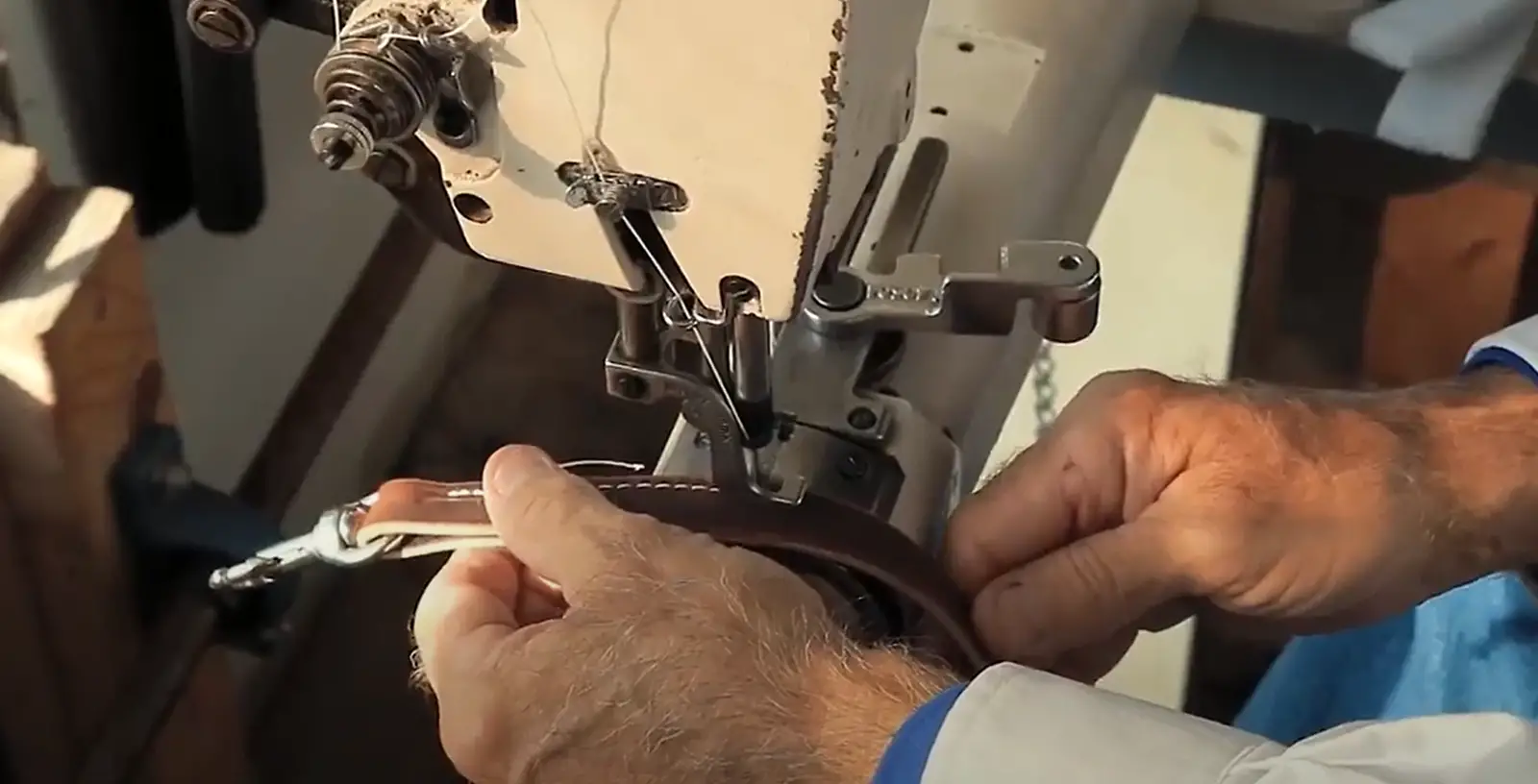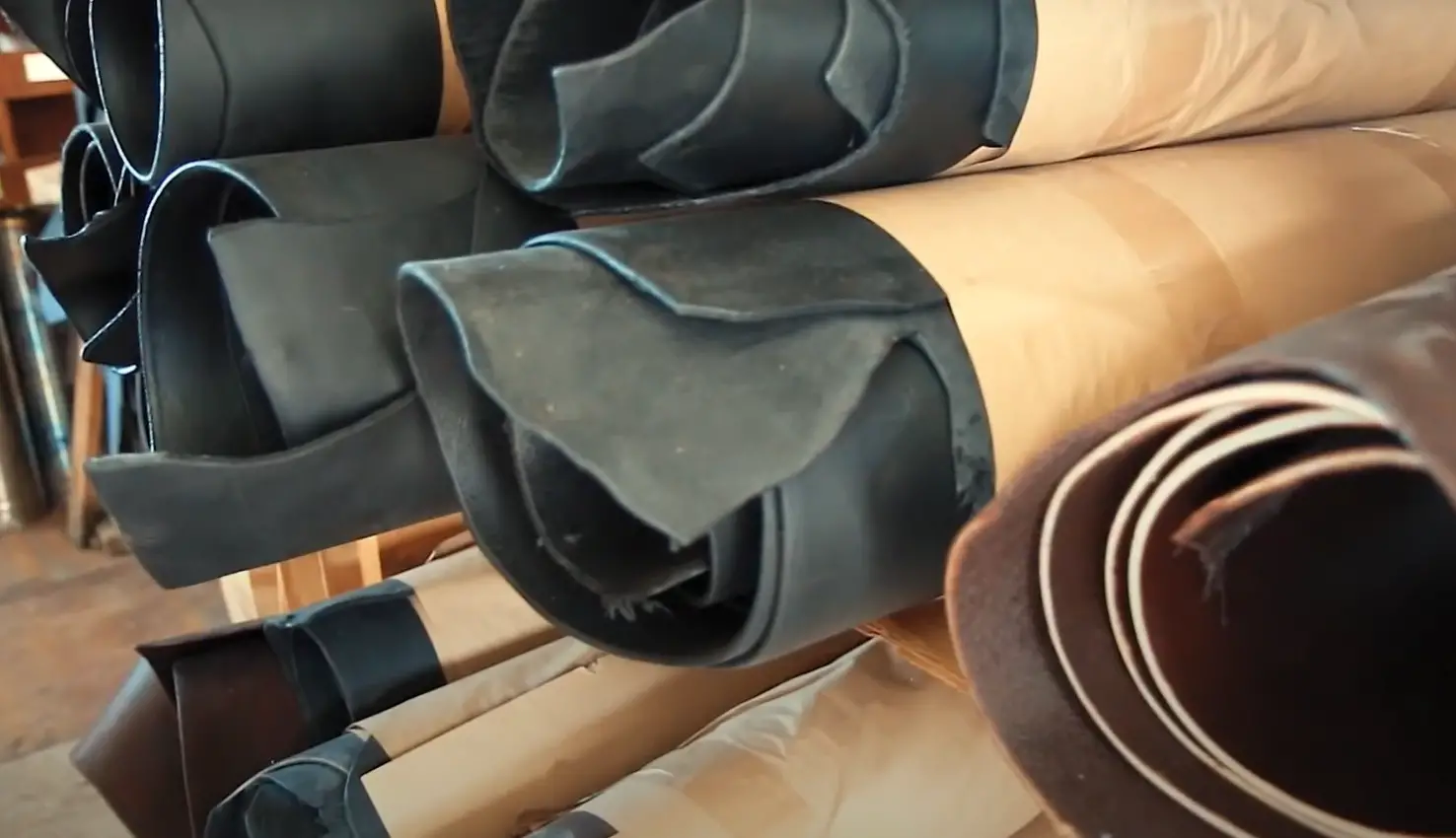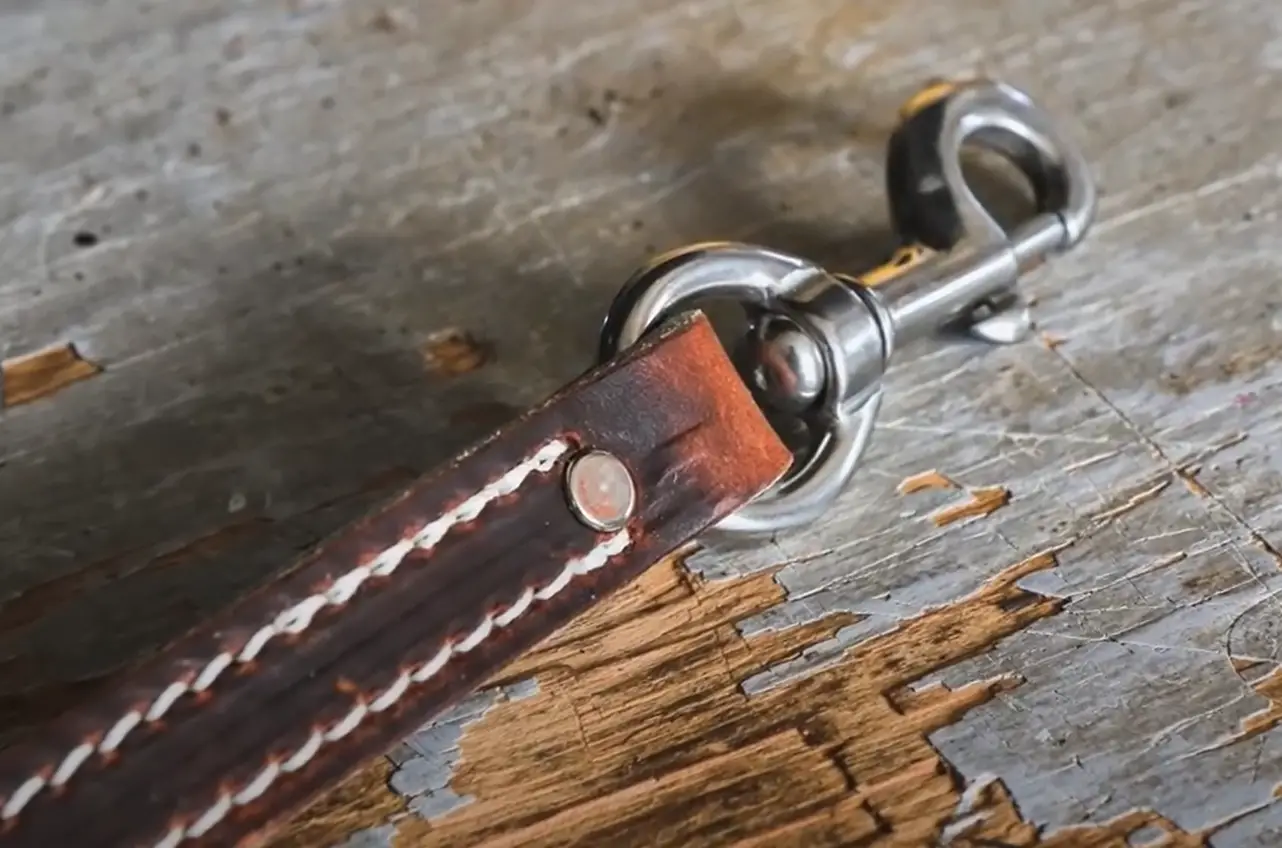What is Latigo leather? This question is often asked by people who are interested in buying this type of leather, but are not sure what it is. Latigo leather is a durable material that can be used for a variety of purposes, such as making shoes, belts, and jackets. In this comprehensive guide, we will answer all of your questions about Latigo leather and provide some tips on how to care for it. Keep reading to learn more!
What is Latigo Leather
THe word “latigo”, means “whip” in Spanish. But what is Latigo leather exactly? Latigo leather is a type of vegetable-tanned leather. What makes latigo leather stand out however, is that it’s created using both vegetable tanning and chrome tanning processes. As a result, it combines the qualities of both worlds: it’s durable like chrome-tanned leather, but has a softer feel like vegetable-tanned leather. [1], [2]
How Does Latigo Leather Compare to Vegetable and Chrome Tanned Leathers?
As you already know, latigo leather is created using both vegetable tanning and chrome tanning processes. This gives it some unique qualities that make it different from both vegetable-tanned and chrome-tanned leathers.
For one, vegetable-tanned leather isn’t as durable as latigo leather. It tends to be more delicate and is therefore better suited for smaller projects like wallets and purses. However it shares similar water-resistance qualities with latigo. It’s also incredibly easy to work with thanks to its flexibility.
Chrome-tanned leather on the other hand, is much more durable than both latigo and vegetable-tanned leathers. It’s often used in projects that require a lot of wear and tear, like upholstery or belts. However it doesn’t have the same softness as either of them, and can be quite stiff. [1]
Production Process of the Latigo Leather
So, how is latigo leather made? The production process of latigo leather starts with the selection of high-quality cowhide. Once the cowhide is selected, it goes through a process of liming and fleshing. After that, the tanning process begins. As we mentioned earlier, latigo leather undergoes both vegetable and chrome tanning processes.

First goes chrome-tanning. Chrome-tanning is a process that uses chromium salts to preserve the cowhide and make it more flexible. The process is faster than vegetable tanning and produces a more pliable leather that is less likely to shrink. After the tanning process, the hide is then dried and rehydrated.
Next, the leather is vegetable tanned. Vegetable tanning is a process that uses tannins and other ingredients found in plants to tan the hide. This results in a leather that is more durable and longer lasting than other types of leather.
After the tanning process, the hide is then infused with a variety of oils and waxes. The techniques used in this process vary depending on the desired end result. For example, some latigo leather is treated using wet-stuffing, a process that infuses the hide with oil and wax after it was nourished. This results in a softer, more pliable leather.
Once the hide has been treated with oil and wax, it is then dyed. The dyeing process can be done using either natural or synthetic dyes. Natural dyes are made from plant materials, while synthetic dyes are made from chemicals.
This completes the production process of latigo leather. As you can see, it is a complex process that involves many steps. However, the end result is a high-quality, durable leather that is perfect for a variety of applications. [1]
Main Applications of Latigo Leather
As you can see latigo leather is brimming with features that make it an excellent choice for a variety of applications.

Footwear is by far the most popular application for latigo leather. This is because latigo leather is both durable and soft, making it comfortable to wear. In addition, the natural oils and waxes in the leather help to protect your feet from the elements.
Advantages of Latigo Leather
So far we only talked about the features of latigo leather superficially. But what are the advantages of latigo leather? Let’s talk a bit more about them.
Appearance
One of the most significant advantages of latigo leather is its appearance. Latigo leather products come in a variety of rich colors that are perfect for any style. It’s mainly available in burgundy, black, and brown. But you can also find it in other colors like yellow and orange. In addition, the leather develops a beautiful patina over time that gives it a unique look. Patina is the result of the natural aging process of leather. It is a thin layer that forms on the surface of the leather and gives it a unique appearance which many people sought as being stylish.
Quality
The quality of latigo leather is one of its most defining features. As we previously covered, latigo leather is made of high quality cowhide. This means that the leather is not only durable, but also has a natural look and feel.
In addition, latigo leather is treated with oils and waxes to improve its appearance. This treatment also helps to protect the leather from water damage and stains.
But of course the main quality latigo leather is famous for, is the mixture of vegetable and chrome tannings. This gives latigo leather an extra layer of protection against elements while still staying moderately rigid.
Durability
Latigo leather is known to be heavy, durable and tough. It is a perfect material to use for products that need to withstand a lot of wear and tear. For example, it is commonly used for horse saddles, reins, and other equestrian equipment.
Latigo leather has a high resistance to stretching and tearing. This makes it ideal for products that need to be strong but flexible, like belts or straps. It is also resistant to abrasion, meaning it will not show signs of wear easily.
Moisture resistance
Water-resistance is also one of the reasons why latigo leather is so popular. Latigo leather is very easy to waterproof. And once it’s waterproofed, it will provide great protection against the elements. This is a critical feature for many applications, especially those that require working in wet or humid environments.
Latigo leather is also very resistant to rot and mold, making it an ideal material for outdoor gear and equipment.
Another advantage of latigo leather’s moisture resistance is that it helps the material last longer. In general, leather products made with latigo will have a longer lifespan than those made with other types of leather.
Of course you shouldn’t expect your latigo leather products to be completely unaffected under a heavy rainfall, but they will definitely withstand light splashes better than other types of leather. [1]
Disadvantages of Latigo Leather
While Latigo leather is one of the most durable materials available, it does have a few disadvantages.

Price
One of the biggest disadvantages of latigo leather is its price. Latigo leather is more expensive than other types of leather, such as faux or bonded leather. This is because the tanning process is more complex and time-consuming. However, the price is worth it when you consider the durability and quality of latigo leather.
Not suitable for patterning
One of the biggest disadvantages is that it is more springy than the other types of leather. This means that it can be difficult to work with, especially when trying to create patterns or detailed designs. Tooling and carving can also be more difficult with latigo, as the leather is less likely to hold onto the shape that you’re trying to give it. [1]
How to Take Care of Latigo Leather
Since latigo leather is such a valuable material, it’s important to know how to take care of it. In this section, we’ll discuss some tips on how to keep your latigo leather products in tip-top shape.

Latigo leather is relatively easy to care for, but it does require some special attention.
Condition the leather
One of the most important things you can do for your latigo leather is to condition it regularly. This will help keep the leather supple and prevent it from drying out and cracking. We recommend you to use a conditioner containing beeswax.
To condition the leather, simply apply a small amount of the conditioner to a clean, soft cloth and rub it into the surface of the leather in a circular motion. Allow the conditioner to soak in for at least an hour before wiping off any excess.
You should condition your latigo leather once every few months or so, or more often if you live in a dry climate or if the leather is exposed to sunlight frequently.
Avoid exposure to moisture
While latigo leather is relatively waterproof, it can still be damaged by exposure to excessive moisture. To protect your latigo leather from water damage, we recommend you avoid getting it wet whenever possible. If the leather does get wet, make sure to wipe the spills immediately.
If you want to take some precautions for extra protection, you can use a water-resistant sealant on your latigo leather. This will help repel water and keep your leather looking good as new. [1]
FAQ
Can latigo leather develop patina?
Latigo leather can develop a patina over time. This means that the leather will become darker and more lustrous with age and use.
What do you use latigo leather for?
Latigo leather is most commonly used in the construction of saddles, horse tack, and other riding equipment. It is also used for making belts, wallets, and other small leather goods.
Latigo leather is prized for its durability and strength. It is able to withstand a great deal of wear and tear, which makes it an ideal choice for products that will see a lot of use.
Is latigo real leather?
Yes, latigo is a real leather. It is made from the hides of cows and other animals. The term “latigo” refers to the process of tanning the hide, which gives it its characteristic qualities of both chrome and vegetable tanned leather.
Latigo leather is known for its durability and strength, making it a popular choice for belts, wallets, and other accessories. It also has a natural resistance to water and stains, which means it can last for many years with proper care. To keep your latigo looking its best, clean it regularly with a soft cloth or brush and store it in a cool, dry place when not in use.
Is latigo leather waterproof?
No, latigo leather is not waterproof. However, it is highly resistant to moisture and can withstand exposure to water better than most other types of leather. Still, if you are planning on using your latigo leather in an environment where it will be exposed to water on a regular basis, you should treat it with a waterproofing agent to help prolong its lifespan.
Useful Video: *Leerburg’s Latigo Leather*
Conclusion
All in all, latigo leather is an excellent material for many applications. It is made from high-quality cowhide that has undergone both vegetable and chrome tanning processes which makes it so unique. The hide is then infused with a variety of oils and waxes to give it the desired properties.
It is strong, flexible, and resistant to moisture and abrasion. Latigo leather also has a beautiful appearance that will develop a rich patina over time. While it is more expensive than other types of leather, its durability makes it worth the investment. So if you’re looking for a high-quality leather, latigo is definitely an option you might want to consider. We hope this guide has helped you learn more about latigo leather and its many benefits. If you have any questions or would like to share your own experiences with this amazing material, feel free to leave a comment below!
References
- https://bestleather.org/types-of-leather/latigo/
- https://nicksboots.com/blog/post/what-is-latigo-leather/







Leave a Reply